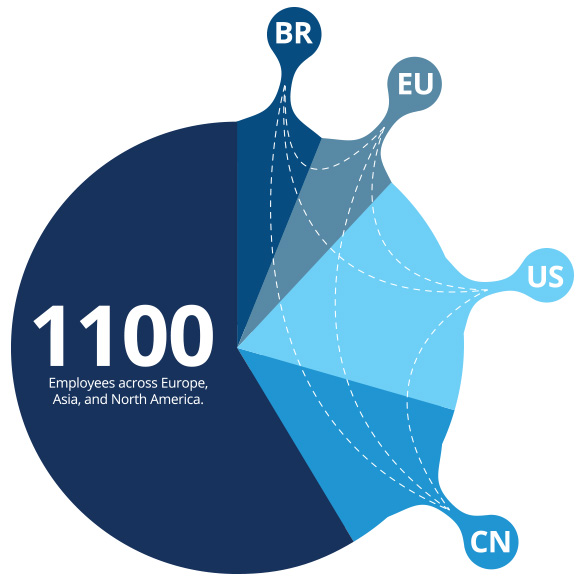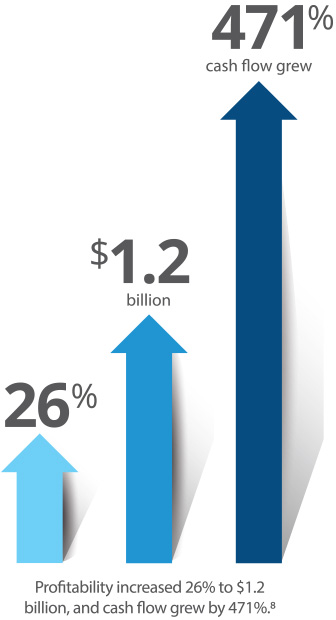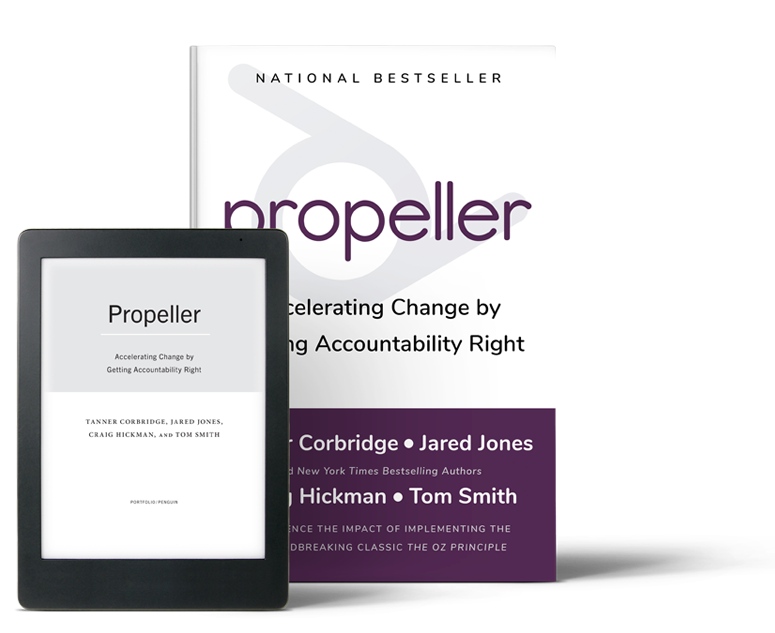Manage Your Culture:
Get Intentional About Employee EngagementAvoiding the Herd Mentality
Among business leaders, a herd mentality has existed around employee engagement rates for the last decade. In the world of dispersed, global workforces, maintaining high levels of employee engagement becomes a critical priority for business leaders everywhere. In fact, according to a 2017 study by Maritz Motivation Solutions, 78% of companies have a documented employee engagement strategy, proving it’s rare to find a company that hasn’t jumped on the employee engagement bandwagon.1
Organizations spend over $720 million each year on employee engagement, and it’s easy to see why.2 According to Gallup, disengaged employees have 37% higher absenteeism, 18% lower productivity, and 15% lower profitability.3 They also cost their companies 34% of their total salary.4 For one employee earning $60,000 a year, a company loses $20,400 annually. The higher the salary, the greater the stakes. On a global scale, employee disengagement translates to approximately $7 trillion in lost productivity.
After decades of measuring engagement, why do 85% of employees across the globe report feelings of disengagement? With billions of dollars funneled into engagement initiatives over the last several years, why have global engagement rates stagnated?

Barriers to Employee Engagement
When an organization is disheartened by low levels of employee engagement, it nearly always falls on the shoulders of management to “fix the engagement problem.” This pressure kicks senior leaders into action-planning mode, where they begin assembling lists of 80-plus ways to improve engagement levels.
This shotgun approach is typically highly decentralized and unfocused, which generates skepticism among employees and leaves management underappreciated for their efforts. As these initiatives prove largely futile year-over-year, a sense of “engagement fatigue” settles in—employees roll their eyes with each new wave of surveys since no real change ever comes of these efforts.
Unfortunately, when leaders spring into action-planning mode without doing critical assessment and groundwork first, their engagement initiatives often fail to gain lasting traction.
The following are three crucial steps that leaders often fail to address before attempting to remedy their engagement problem:
1. Identifying the root cause.
When addressing low employee engagement, many companies fail to get to the root cause of poor employee engagement. That’s because engagement assessments are designed for measuring an outcomes—such as overall engagement rates—without attempting to address many of the deeper, cultural challenges underpinning employee satisfaction. Only leaders who get to the source of the problem are able to boost employee engagement in a sustainable way.
2. Providing systemic solutions.
Modern employee engagement assessments generate metrics, but they are rarely prescriptive. Without proven solutions that shift existing cultural norms, management teams introduce quick-fixes that serve as mere Band-Aids to more deeply rooted issues.
3. Encouraging ownership.
Employee engagement assessments without actionable solutions cause employees to externalize the need to “fix engagement” onto management’s shoulders. The workforce tends to collectively think, “I hope management figures it out this year. They’ve got a lot of work to do to right this ship.” By working to cultivate a sense of personal, psychological ownership over existing problems in every employee, leaders build an accountable, engaged culture.
Intentionally Shaping Culture Through New Experiencest
The real work begins when leaders push aside the metrics they’ve gleaned from employee engagement assessments and start focusing on improving their corporate culture first.
Employees crave a workplace culture that is open and transparent — one that promotes collaboration and trust. However, perhaps most importantly, they want to feel heard and valued. Whether or not a frontline employee feels heard is based on their daily experiences in the workforce.
This is the foundation of The Results Pyramid®, a simple, powerful way of understanding the connection between culture (defined by the way people think and act) and the organizational results that are achieved.
According to The Results Pyramid, experiences shape beliefs, which subsequently inform the actions that drive results. Here’s how it works from an engageme
Here’s how it works from an engagement perspective: if a leader says he or she values open communication, yet closes his or her office door daily and fails to respond to emails, he or she creates experiences that foster the belief among reports, “My thoughts and feedback are not wanted or welcomed here.” Failing to feel recognized or valued, employees shut down. As a result, creative-problem solving comes to a standstill and employee engagement levels plummet.
Experiences shape beliefs, that subsequently inform the actions that drive results.
No action plan — no matter how well-designed — will cause employees to ignore leaders’ self-contradictory behavior.
hat facilitate open, honest, and candid conversations are able to shift beliefs in the right direction.
While this can prove especially challenging for leaders managing a dispersed workforce, it’s entirely possible through focused, targeted efforts.
Novelis, Part 1: A Global Leader Enacts Transformational Change
When Steve Fisher was promoted from CFO to CEO of Novelis, the world’s largest producer of flat-rolled aluminum, he knew full well that the company’s future depended on quick and decisive action. For the past few years, Novelis had been posting dismal financial performance and low engagement rates among it’s more than 11,000 employees across Europe, Asia, and North America.
At the root of it all was a workplace culture that deterred employees from openly sharing their creative ideas. Many of Fisher’s employees had insightful feedback on how to improve the business, but felt there was no safe space in which to share it. There was an underlying current of “keeping quiet” that prevented the organization from taking the steps it needed to grow.

Storytelling is a powerful tool leaders use to create experiences and manage culture. Stories can spread across the organization like wildfire, as they did at Novelis, prompting employees at all levels of the organization to take action and recognize one another for their daily contributions
At the same time, recognizing employees publicly and privately for their hard work had become a nicety rather than a “must-have” within the company culture. As a result, employees felt stifled and underappreciated.
Fischer set out to change the culture. Over the course of a year, the company adopted a “say anything” culture. In fact, “say anything” became a mantra that shifted the actions and behaviors of leaders at the top and, ultimately, at every level of the organization.
To facilitate this new culture, Fischer and his team designated specific “culture champions” at their offices across the world.6 These employees were identified for their hard work, outstanding performance, and, most importantly, the ways in which their behavior reflected the new cultural values of the “say anything” philosophy
The culture champions participated in four-hour culture training programs that taught them how to create experiences for their colleagues that promote candid conversation, targeted feedback, and focused recognition.
For example, an engineer in China wrote a “Focused Recognition” card for a Novelis technician in Oswego, New York who spent 10 hours via WebEx helping him fix a faulty manufacturing line. He detailed the technician’s support and sent the card to the Oswego office, allowing the whole team to witness this highly intentional act of recognition. Stories of this nature spread across the organization like wildfire, prompting employees at all levels of the organization to take action and recognize one another for their daily contributions.
In addition to these efforts, Fischer and his team hosted workshops to address the unique cultures and traditions within certain countries. For example, in Korea, where it is often difficult for employees to tell their boss that he or she is wrong, Fischer had to convince frontline employees and C-suite executives alike that at Korea Novelis, there is a respectful way to challenge a superior or provide critical feedback. The more that leaders in Korea graciously accepted the feedback and insights of their employees, the more employees felt comfortable coming to the table with new, innovative ideas. Over the course of the year, employees began feeling that they were an integral part of the fabric of Novelis.
Tying engagement to accountability
Current employee engagement strategies tend to do very little to engender a sense of employee ownership in the engagement process. In fact, employee engagement assessments often do exactly the opposite — prompting employees to externalize the need to fix engagement onto the to-do lists of upper management.
For years, we’ve coached leaders on how to reframe the engagement conversation and turn it into an accountability for results conversation. This reorientation is critical.
In the national bestseller Propeller: Accelerating Change by Getting Accountability Right, we unpack how accountability is a personal choice to rise above one’s circumstances and demonstrate the ownership necessary for achieving desired results.
Leaders put an end to a pattern of externalization when they zero in on personal accountability in the workplace. This is because accountable employees take ownership for driving their own improvement.
They proactively seek feedback, adjust performance accordingly, and deliver better results. In fact, data from the Partners In Leadership Workplace Accountability Index indicates that employees are 59% more engaged with their work when there is a culture of accountability in place within the organization.7
Leaders and frontline employees alike who hold themselves accountable are committed to the four Steps To Accountability: See It, Own It, Solve It, Do It®. For example, an accountability-driven retail associate is one who notices which items in the store aren’t selling (See It), commits to addressing the issue (Own It), finds creative ways to address the problem — such as rearranging the window displays (Solve It) — and then implements the solution and proactively attempts to improve sales (Do It). Because this associate “owns” the problem and sets out to resolve it, they engage more deeply in their work and invest more in the success of the organization at large.
Novelis, Part 2: Creating a Culture of Accountability

Source: Corbridge, T., et al. (2019). Propeller: Accelerating Change by Getting Accountability Right
Taking the stage at the company’s 2015 Global Leadership Summit, Fisher began his speech: “You might not see it right now, but we have the opportunity to do something extraordinary. We have the chance to turn this company around and achieve a level of unprecedented results….There is a blue ocean of opportunity in front of us. However, as a company, I’ve become convinced we will drown in that ocean if the people in this room don’t change. Accountability must be our vehicle for change.”
Fisher’s speech served as a rallying cry that signaled leadership’s intention to put accountability at the helm of their operations. Employees at every level took notice.
As leaders took ownership over the problems at hand rather than externalizing accountability, others followed suit. Instead of saying, “It’s not my problem” to the Novelis engineer in China, the technician in Oswego spent 10 hours helping his colleague across the globe get the line back up and running. The recognition he received for this act further cemented the fact that accountability pays off.
With a culture rooted in accountability, candid communication, and focused recognition, Novelis saw the transformation Fisher had been hoping for. Engagement scores rose to historic levels. Return on capital employed almost tripled, profitability increased 26% to $1.2 billion, and cash flow grew by 471%.8
Stepping beyond the bounds of traditional employee engagement
Authentic employee engagement hinges on creating a culture that produces desired outcomes. From our experience, the most effective approaches to engagement are those that create cultural movements designed to bolster employee engagement levels and productivity through personal accountability.
When employees each feel a sense of ownership for achieving shared results, they engage deeply with their work and go above and beyond to get the job done. In the process, they contribute to creating a flourishing culture of recognition and teamwork, further bolstering topline performance.
It’s time to push aside employee engagement assessments as we know them and put new processes into place that get to the root of the problem. Even from miles and miles away, leaders can focus on creating valuable experiences for employees that facilitate the creation of new beliefs and actions, thereby shifting the cultural landscape of the corporation. All it takes is one highly intentional experience to create a ripple effect of many more. Only when this happens will leaders see employee engagement levels soar.
Move beyond the article
Intentionality in today’s age requires a distinct tools set to move past everyday challenges. Being able to put out the next big fire on your team or in the organization requires fast effective action.
Buy NowStart with chapter 3: Clean up on isle 9!
Download ChapterWhat’s inside
> Reaching your goals at hyperspeed means knowing when to slow down.
> Reaching your goals at hyperspeed means knowing when to slow down.
> Reaching your goals at hyperspeed means knowing when to slow down.

